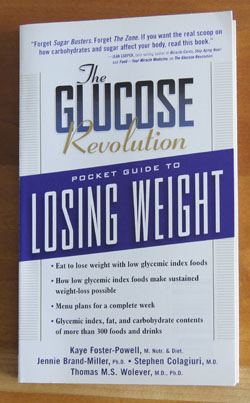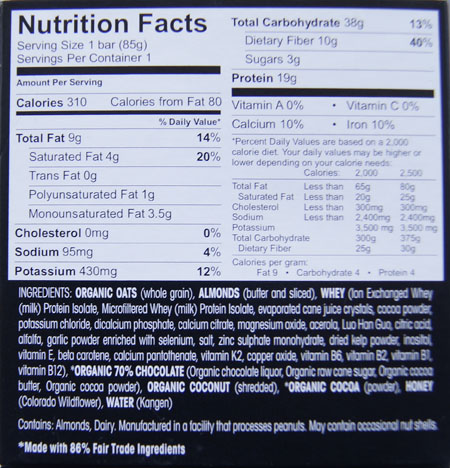Cookbook #197: The Glucose Revolution Pocket Guide to Losing Weight, Kaye Foster-Powell, Jennie Brand-Miller, Stephen Colaguiuri, and Thomas M.S. Wolever, Marlowe and Company, NY, NY, 2000.
 My Whole Foods basket overflowing with fresh fruits and vegetables, I rolled towards a sample table last Thursday. The enthusiastic young man had laid out samples of yet another protein bar for the sports enthusiasts of Boulder. I was about to pass on by, but I heard the words “low glycemic index” . . . that stopped me.
My Whole Foods basket overflowing with fresh fruits and vegetables, I rolled towards a sample table last Thursday. The enthusiastic young man had laid out samples of yet another protein bar for the sports enthusiasts of Boulder. I was about to pass on by, but I heard the words “low glycemic index” . . . that stopped me.
A little bell rang in my head: “I have a book on my cookbook shelf on the glycemic index of foods. I’ll do that book next, and in the meantime, I’ll buy one of his protein bars!”
 Little did that young man know that he was the inspiration for this week’s blog post.
Little did that young man know that he was the inspiration for this week’s blog post.
The Glucose Revolution Pocket Guide to Losing Weight is all about the “glycemic index” of foods. Why is the glycemic index important? Low glycemic index foods help stabilize blood glucose levels. Spikes in glucose are related to insulin levels, and thus to diabetes. For the dieter, low GI foods keep you feeling full longer. The Glucose Revolution Pocket Guide, page 9: “The glycemic index is a clinically proven tool in its applications to diabetes, appetite control and reducing the risk of heart disease.” One chapter gives sample diet plans, and another lists healthy snacking techniques. At the end of the book is a lengthy table of the glycemic index of many foods.
(I covered another cookbook for diabetics: The Calculating Cook. I’ve always found that while dieting, keeping a strict eye on carbohydrates is a must.)
How is the glycemic index of a food measured? The researchers recruit volunteers, feed them equivalent carbohydrate amounts of foods, then measure their glucose levels by sampling their blood over several few hours. All foods are compared with a reference food, pure glucose, which is arbitrarily assigned a value of 100.
Here are some sample glycemic index (GI) values (from this book):
- peanuts, 1/2 cup: 14
- barley, 1/2 cup: 25
- milk, 1 cup: 27
- kidney beans, 1/2 cup: 27
- garbanzo beans, 1/2 cup: 33
- apple, 1 medium: 38
- spaghetti, whole wheat, 1 cup: 37
- spaghetti, white, 1 cup: 41
- bread, 100% wheat bread, 1 1/2 ounce: 53
- sweet potato, 1/2 cup mashed: 54
- banana: 55
- potato, white, 1/2 cup mashed: 91
- bread, white french baguette, 1 ounce: 95
From the above examples, you see that foods that are not classified as carbohydrates such as peanuts or milk naturally have a low glycemic index (GI) value. Fruits in general are low GI. Legumes like garbanzos and kidney beans are low. Whole wheat bread has a GI of 53, while white bread has a value of 95. Sweet potatoes have a value of 54, while white potatoes have a value of 91.
Kind of justifies the old “health food” adage that whole wheat bread is better for you than white wheat bread. Go for complex carbohydrates!
I found that I had downloaded and saved a 2002 journal article on the topic of glycemic index – this subject has interested me for quite a while:
-
International table of glycemic index and glycemic load values: 2002, Kaye Foster-Powell, Susanna HA Holt, and Janette C Brand-Miller, Am J Clin Nutr, 2002;76:5–56.
Note that the lead author of this journal article is Kaye Foster-Powell, the lead author of The Glucose Revolution Pocket Guide to Losing Weight. The 2002 journal article defines a related value, “glycemic load”, which is the glycemic index normalized to the amount of carbohydrate in a particular food:
glycemic load, or “GL” + (GI x the amount of carbohydrate) divided by 100.
Kaye Foster-Powell is a co-author of a 2008 article on glycemic index:
-
International Tables of Glycemic Index and Glycemic Load Values: 2008, Fiona S. Atkinson, Kaye Foster-Powell, and Jennie C. Brand-Miller, Diabetes Care, 2008 Dec; 31(12): 2281–2283.
Both of the above articles have tables of GI and GL values. You can also search for the GI or GL value for a food online:
- The University of Sydney comprehensive site
- Glycemc Index Foundation, especially friendly, easy to understand list of foods to eat to go “low GI”
- Fitness Magazine low GI foods with a list of common foods that are low GI (GI under 55)
I especially like the University of Sydney site because you can enter a food and find out both its GI and GL. It’s a comprehensive site that explains all that you might want to know about glycemic index.
The Great Courses on nutrition
I am a big fan of The Great Courses, audio university-level lectures on a multitude of topics. Years ago I purchased “Nutrition Made Clear” by Roberta H. Anding; I highly recommend it. Dr. Anding discussed glycemic index in lecture 6, “Not All Carbohydrates Are Created Equal”, and lecture 22, “Metabolic Syndrome and Type 2 Diabetes”. She also referenced the 2002 J. Clin. Nutrition article by Foster-Powell, K. et al.
What to cook for this blog?
Since there are no recipes in The Glucose Revolution Pocket Guide to Losing Weight, I decide to cook a low GI/GL food and use it . . . somehow! I found some dried garbanzo beans in my pantry. Also known as chickpeas, they have a GI of 31 and GL of 9. I cooked a big batch in my electric pressure cooker.
 I will put these pretty beans in green salads and main dish salads (I have a great recipe for a Mediterranean salad). I can use them for hummus (I’ve made it many times before). They freeze well, so I froze several containers for later use. Garbanzo beans should be a healthy addition to our diet.
I will put these pretty beans in green salads and main dish salads (I have a great recipe for a Mediterranean salad). I can use them for hummus (I’ve made it many times before). They freeze well, so I froze several containers for later use. Garbanzo beans should be a healthy addition to our diet.
And what of the Vukoo bar? “Glycemic index” is not noted on the bar’s label. But the three major ingredients, oats (GL of 11), almonds (not a carbohydrate), and whey (a protein) do have low GL. The young man giving us samples claimed that half a bar kept one of his friends hunger-free for several hours. I found that little pieces of this bar kept me full between meals – it took me a week to finish it.

